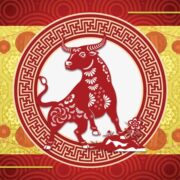
FEBRUARY 12 will mark the biggest event on the Chinese calendar, ushering in the beginning of the Year of the Ox.
Unlike the fixed new year of the Gregorian calendar commonly celebrated on January 1st, the date of the Lunar New Year varies, determined by the appearance of the new moon — which is why it’s called the Lunar New Year, as it’s based on the lunisolar Chinese calendar.
The Lunar New Year usually falls sometime between January 21 and February 20. It will be on the 12th of February, a Friday, this year.
The Ox is the second animal in the Chinese zodiac. One myth said that the animals were decided in the order in which they arrived at a party thrown by the Jade Emperor. The Ox was set to be the first to arrive, but the Rat tricked the Ox into giving him a ride. As they arrived at the party, the Rat jumped down and landed in front of the Ox.
The 12 zodiac animals are, in order: Rat, Ox, Tiger, Rabbit, Dragon, Snake, Horse, Goat, Monkey, Rooster, Dog, and Pig.
According to ChineseNewYear.net, the Ox in the zodiac is seen as hardworking, honest, and earnest. It is also patient, and thinks logically. The Ox never looks for praise or to be the center of attention. However, the Ox can be stubborn, and might not have the best communication skills.
Those who are born in the year of the Ox — 2021 as well as 1961, 1973, 1985, 1997, and 2009 — share the aforementioned traits with the animal.
Traditions and superstitions
Similar to the Jan. 1 New Year, Lunar New Year is observed with traditions and rituals to attract good luck and fortune for the coming year.
Filipinos who celebrate the holiday typically flock to Binondo in Manila, which is considered the oldest Chinatown in the world.
They crowd the streets of Chinatown to watch the Parades of Dragons and Lions, a colorful and dynamic performance accompanied by the loud banging of drums and cymbals. The dragon, in China, is believed to represent great power, auspiciousness, and strength. Meanwhile, the lion represents safety and luck.
The color red is prevalent during the festivities as it is a special color in Chinese culture, signifying energy, happiness, and good luck. Most people wear red clothing as it represents vitality as well as strength. Elders also hand out Ang Pao (Red envelopes) to children. These envelopes contain money, and giving them is believed to bring good luck and long life to both the giver and receiver.
The Lunar New Year won’t be complete without setting off fireworks and firecrackers or generally just making noise as it is supposed to drive away bad spirits, bad luck, and the mythical beast called Nian. Filipinos commonly use horns and cooking pots to create noise.
Families also gather to have their New Year’s Eve dinner where they usually serve tikoy (year cake), which is made from sticky rice and symbolizes unity among family members; pancit/noodles, for long life and represent the eater’s life; and fish and dumplings, which are believed to signify good fortune.
Families also prepare 12 different round fruits as they are believed to bring luck and fortune to them. The New Year’s Eve dinner is perhaps the most important dinner for families — that’s why it’s necessary for all the members of the family to be present for it.
During the Lunar New Year, people across the globe greet with either Gong Xi Fa Cai, which means “you attain greater wealth,” or Kung Hei Fat Choi, which means “congratulations and be prosperous.”






